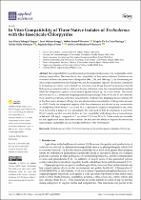| dc.contributor.author | Sabogal-Vargas, Ana María | |
| dc.contributor.author | Wilson-Krugg, Juan | |
| dc.contributor.author | Rojas-Villacorta, Walter | |
| dc.contributor.author | De La Cruz-Noriega, Magaly | |
| dc.contributor.author | Nelida Milly, Otiniano | |
| dc.contributor.author | Rojas-Flores, Segundo | |
| dc.contributor.author | Mendoza-Villanueva, Karol | |
| dc.date.accessioned | 2023-11-02T14:58:07Z | |
| dc.date.available | 2023-11-02T14:58:07Z | |
| dc.date.issued | 2023-01-06 | |
| dc.identifier.uri | https://hdl.handle.net/20.500.13067/2740 | |
| dc.description.abstract | The compatibility between biocontrol agents and pesticides seems to be a sustainable control strategy in agriculture. Therefore, the in vitro compatibility of three native isolates of Trichoderma was evaluated in three concentrations of chlorpyrifos (960, 1200, and 1440 mg/L), by determining the effect on spore germination, mycelial growth, and the antagonistic capacity. The isolates correspond to Trichoderma asperellum TCA 3, Trichoderma asperellum TCA 21 and Trichoderma harzianum TCA 23. Both spore germination and mycelial growth were performed using the poisoned medium method, while the antagonistic capacity was evaluated against Botrytis sp. in a dual culture. The results showed that TCA 21 strain had a higher germination percentage (79.46, 59.79, and 37.43%) than the TCA 3 and TCA 23 strains, in the three concentrations of chlorpyrifos. Regarding the mycelial growth of the three native strains in chlorpyrifos are affected when concentration of chlorpyrifos increase (p < 0.05). Finally, the antagonistic capacity of the three strains was not affected by any concentration of chlorpyrifos, where strains TCA 21 and TCA 23 presented a degree of antagonism of one, while TCA 3 presented a degree of two, according to the scale used by Bell. In conclusion, T. asperellum TCA 21 was the one that presented the best in vitro compatibility with chlorpyrifos at concentrations of 960 and 1200 mg/L, compared to T. asperellum TCA 3 and TCA 23. These results are favorable for field application since these native strains can also have the ability to degrade the insecticide, representing a sustainable and eco-friendly alternative to the environment. | es_PE |
| dc.format | application/pdf | es_PE |
| dc.language.iso | eng | es_PE |
| dc.publisher | MDPI | es_PE |
| dc.rights | info:eu-repo/semantics/openAccess | es_PE |
| dc.rights.uri | https://creativecommons.org/licenses/by/4.0/ | es_PE |
| dc.subject | Trichoderma asperellum | es_PE |
| dc.subject | Trichoderma harzianum | es_PE |
| dc.subject | Biocontrol agent | es_PE |
| dc.subject | Pesticides | es_PE |
| dc.subject | Botrytis sp. | es_PE |
| dc.title | In Vitro Compatibility of Three Native Isolates of Trichoderma with the Insecticide Chlorpyrifos | es_PE |
| dc.type | info:eu-repo/semantics/article | es_PE |
| dc.identifier.journal | Applied Sciences | es_PE |
| dc.identifier.doi | https://doi.org/10.3390/app13020811 | |
| dc.subject.ocde | https://purl.org/pe-repo/ocde/ford#2.07.00 | es_PE |
| dc.source.volume | 13 | es_PE |
| dc.source.issue | 2023 | es_PE |
| dc.source.beginpage | 1 | es_PE |
| dc.source.endpage | 11 | es_PE |


